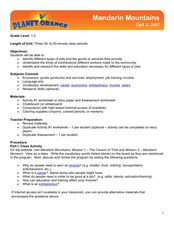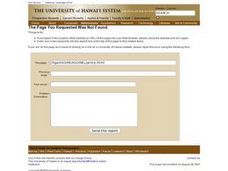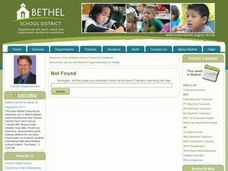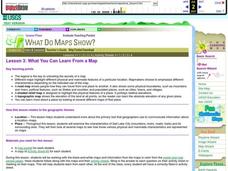Curated OER
American Indian Art
Students complete a unit of study about Native American visual art. In this visual art lesson, students complete five lessons to study Native American art.
Curated OER
Mandarin Mountains: Get a Job
Learners consider career options. In this career lesson, students use a selected Internet source to explore various jobs as well as the skills required for them. Learners also consider the contributions of workers to the communities they...
Curated OER
Matter and Energy
Students investigate the effects of air pressure on humans by utilizing the Internet. In this physical science instructional activity, students research the Internet to discover altitude sickness and air pressure. Students prepare...
Curated OER
Rollin’ on the River: Identifying Jargon
Pupils identify jargon in poetry, prose and fiction. In this literature activity, students will read selections from Mark Twain and identify figurative langauge, focusing on jargon.
Curated OER
A State Divided - Maryland in the Civil War Era
Students use primary sources to see how Maryland was a divided state during the time leading up to the Civil War. In this Civil War lesson plan, students go over vocabulary, and look at maps that show the division of opinions of people...
Curated OER
CRM in Tennessee
Eleventh graders examine the the Civil Rights Movement in Tennessee. In this state history lesson, 11th graders create a timeline of events. Students write journal entries about their visit to the Nashville Public Library.
Curated OER
America Grows - Trailblazers Pave the Way
Students study the time period after the Revolutionary War when people were striving to move away from the coastal areas and look for pathways to the west. Westerward expansion is a central theme and students use a variety of resources...
Curated OER
Geography of China (Tibet)
Sixth graders study the geography of Tibet. They create maps of Tibet. Students predict population, land area, water area and coastline length of the United States and Tibet. Students compare and contrast the day-to-day lives of people...
Curated OER
Cartogram of the Great Compromise
Young scholars create cartograms of populations during 1790.
Curated OER
Pets Around the World
Learners communicate via e-mail with other students to learn about pets, animals of interest , and geography from different parts of the world. Vocabulary focuses on rural, urban, and suburban areas.
Curated OER
How Mountains Shape Climate
Students use raw data to make a climatograph; they explain the process of orographic precipitation and the concept of a rain shadow.
Curated OER
Music to Learn Countries and Capitals Around the World: Learning Countries and Capitals in Asia
Students use musicto explore the countries and capitals of Asia.
Curated OER
Title: Rivers as Borders
Students are introduced to the concept of borders. They read maps and identify rivers that separate different countries and states. They examine how or why a landform such as a river border might be the reason for different cultures.
Curated OER
The Magic of Cranberries
Students research climatic and soil conditions for growing cranberries and illustrate how cranberries grow. They research how cranberries are used past and present and create an a-b-c book on cranberries.
Curated OER
Scarcity of Land Throughout the World and in Hawaii
Students discuss the importance of "land." They review the four types of land classification--urban, rural, agricultural and conservation--and participate in an activity involving an apple that demonstrates the use of land in Hawaii....
Curated OER
Theobroma - Food of the Gods
Students discuss the history of cacao and its use in the production of chocolate. They analyze actual cacao pods and record their observations. Finally they create a five minute contour drawing of the cacao pod and seeds.
Curated OER
The Fabric of Our World
Students discuss cultural diversity, and examine how the community reflects the cultural background of the inhabitants. They read the book, People, take a community walk, create a rainbow chart, and research other states for relocation...
Curated OER
Mapping the Lewis and Clark Trail
Students explore how physical and human geography features effected Lewis and Clark's expedition by using the Lewis and Clark Digital Discovery Web site.
Curated OER
Time Zones
Young scholars study the reason why time zones exist and how they are established. They predict time zones for different places on Earth.
Curated OER
What You Can Learn From a Map
Students investigate the use of road maps, shadeded relief maps, and topographic maps.
Curated OER
Introduction to Maps
Young scholars investigate a variety of maps to explain what each one is used for.
Scholastic
Perfect Postcards: Illinois
Connect the geography and history of Illinois using an art-centered lesson on the railroads. The railroad connected once-distant places, particularly in the Midwest. Using research, class members create postcards of fictional cross-state...
Curated OER
What do Maps Show: How to Read a Topographic Map
Students identify the characteristics of topographical maps. Using examples, they practice reading them and describing the information they gather from them. They also discover how to use the website from the U.S. Geological Survey.
Other popular searches
- Esl the Geographic Location
- Iceland Geographic Location
- Geographic Location Clues
- Major Geographic Locations

























